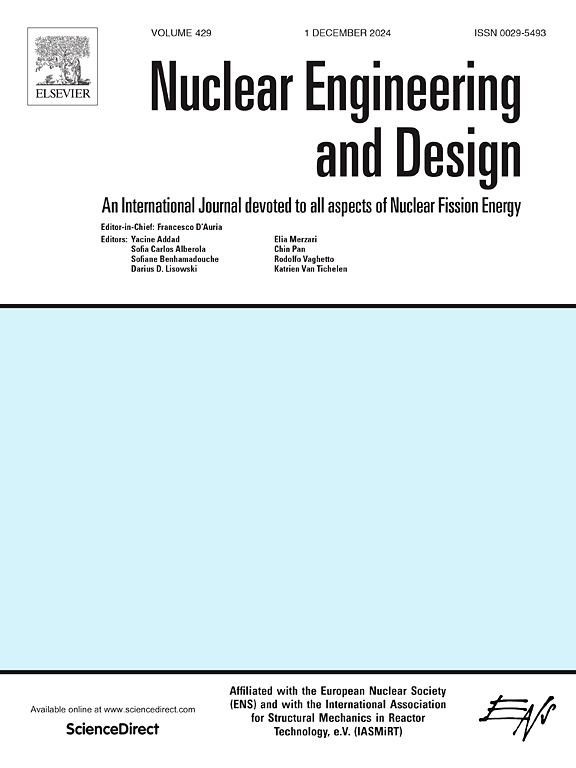Investigation of external heat transfer characteristics in a partially submerged vertical heat exchanger tube bundle
IF 1.9
3区 工程技术
Q1 NUCLEAR SCIENCE & TECHNOLOGY
引用次数: 0
Abstract
A passive residual heat removal heat exchanger (PRHR HX) is commonly employed in nuclear reactors to dissipate decay heat from the reactor core during design extension conditions. In the later stages of such accidents, the coolant level in a storage tank may drop, leading to partial exposure of the heat transfer tubes. To investigate the effect of reduced coolant levels on shell-side heat transfer performance in a vertical tube bundle, an experimental setup was designed, featuring four coolant levels: full, 4/5, 2/3, and 1/2. Saturated steam was introduced to the inner side of the tubes, while distilled water served as the coolant on the outer shell side. High-speed imaging and precise thermal measurements enabled the observation and analysis of three distinct heat transfer regions: nucleate pool boiling, liquid film evaporation, and steam convection. A new method was proposed to calculate heat transfer coefficients, accounting for the complex phenomena in the liquid film evaporation region at low coolant levels. The results indicate that shell-side heat transfer performance does not degrade linearly with decreasing coolant levels. At the 4/5 and 2/3 coolant levels, intensified thermal disturbances from water jet impacts and liquid film falling improved heat transfer. Even at the 1/2 coolant level, the heat removal capacity remained over 75 % of that at full submergence, due to effective phase-change heat transfer in the liquid film region. This study concludes that PRHR HX systems can maintain effective heat removal even at reduced coolant levels, driven by film evaporation and droplet impingement mechanisms. These findings offer valuable insights for the thermal design and safety analysis of passive cooling systems in advanced nuclear power plants.
部分浸没式垂直换热器管束外换热特性研究
无源余热去除热交换器(PRHR HX)通常用于核反应堆在设计扩展条件下从堆芯消散衰变热。在此类事故的后期阶段,储罐中的冷却液水平可能下降,导致传热管部分暴露。为了研究冷却剂水平降低对垂直管束壳侧换热性能的影响,设计了四种冷却剂水平的实验装置:满、4/5、2/3和1/2。饱和蒸汽被引入管内,而蒸馏水作为冷却剂在外壳侧。高速成像和精确的热测量能够观察和分析三个不同的传热区域:核池沸腾,液膜蒸发和蒸汽对流。针对低冷却液水平下液膜蒸发区的复杂现象,提出了一种新的传热系数计算方法。结果表明,壳侧传热性能不随冷却剂水平的降低而线性降低。在4/5和2/3冷却剂水平,水射流冲击和液膜下降引起的热扰动加剧,改善了传热。即使在1/2冷却液水平,由于液膜区域有效的相变传热,排热能力仍保持在完全浸入时的75%以上。该研究得出结论,PRHR HX系统在膜蒸发和液滴撞击机制的驱动下,即使在冷却剂水平降低的情况下,也能保持有效的散热。这些发现为先进核电站被动冷却系统的热设计和安全性分析提供了有价值的见解。
本文章由计算机程序翻译,如有差异,请以英文原文为准。
求助全文
约1分钟内获得全文
求助全文
来源期刊

Nuclear Engineering and Design
工程技术-核科学技术
CiteScore
3.40
自引率
11.80%
发文量
377
审稿时长
5 months
期刊介绍:
Nuclear Engineering and Design covers the wide range of disciplines involved in the engineering, design, safety and construction of nuclear fission reactors. The Editors welcome papers both on applied and innovative aspects and developments in nuclear science and technology.
Fundamentals of Reactor Design include:
• Thermal-Hydraulics and Core Physics
• Safety Analysis, Risk Assessment (PSA)
• Structural and Mechanical Engineering
• Materials Science
• Fuel Behavior and Design
• Structural Plant Design
• Engineering of Reactor Components
• Experiments
Aspects beyond fundamentals of Reactor Design covered:
• Accident Mitigation Measures
• Reactor Control Systems
• Licensing Issues
• Safeguard Engineering
• Economy of Plants
• Reprocessing / Waste Disposal
• Applications of Nuclear Energy
• Maintenance
• Decommissioning
Papers on new reactor ideas and developments (Generation IV reactors) such as inherently safe modular HTRs, High Performance LWRs/HWRs and LMFBs/GFR will be considered; Actinide Burners, Accelerator Driven Systems, Energy Amplifiers and other special designs of power and research reactors and their applications are also encouraged.
 求助内容:
求助内容: 应助结果提醒方式:
应助结果提醒方式:


